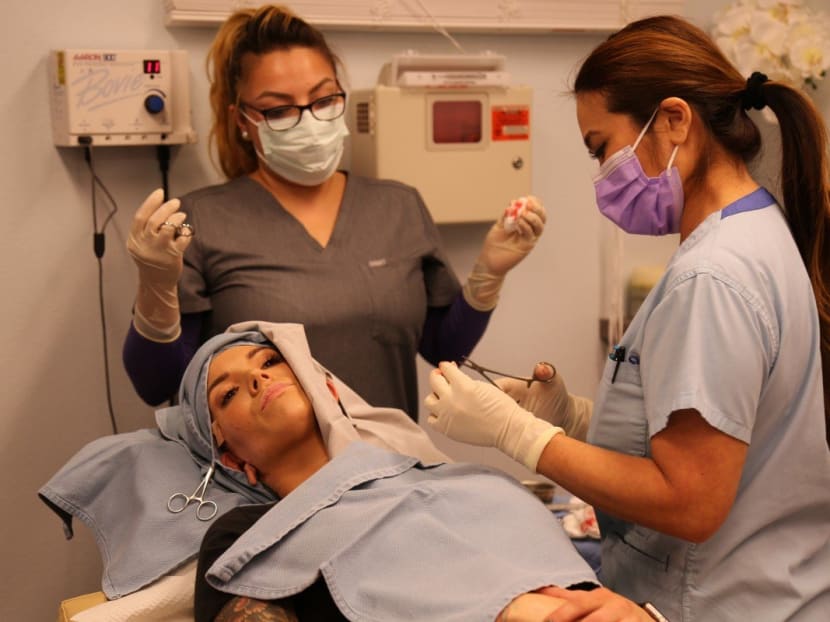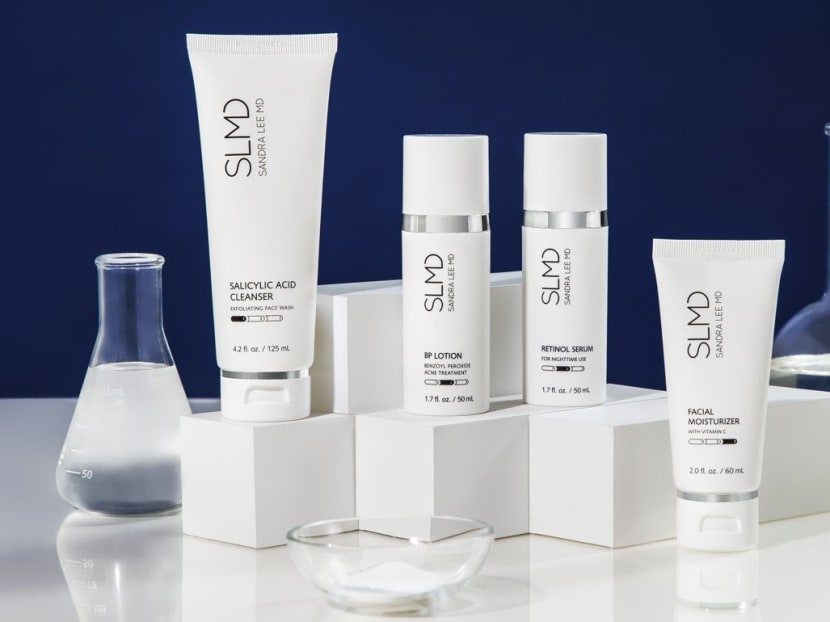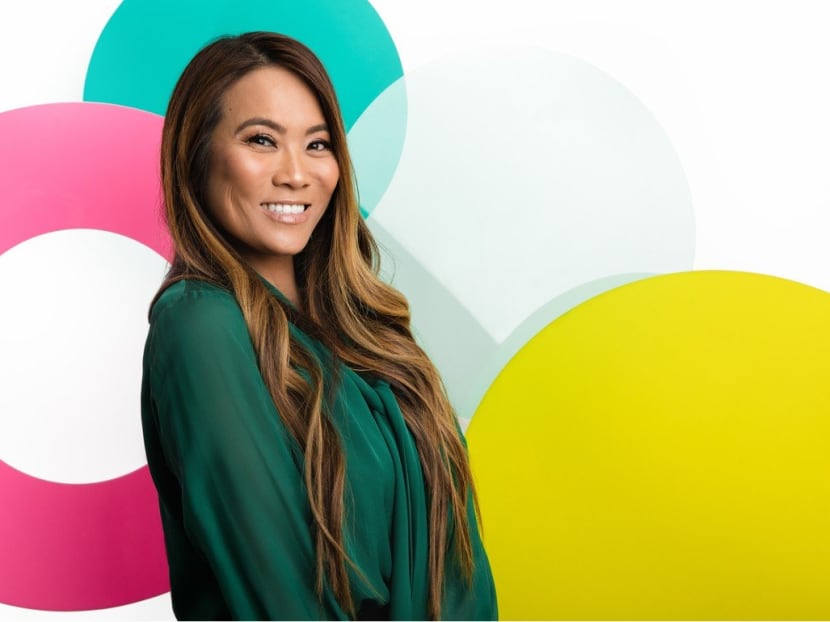Dr Pimple Popper: California dermatologist stunned by how many people get a kick out of ick
UPLAND, CALIFORNIA (USA) — Dr Sandra Lee was running a successful medical practice in Upland, a city in California about 50km outside Los Angeles, seeing patients with a roster of general dermatological issues when she posted a video of herself on the clinic’s Instagram account doing a blackhead extraction.

American dermatologist Dr Sandra Lee (right) carries out surgery on patient Noelle’s ear. Her YouTube skincare videos have been seen more than 2.6 billion times.
UPLAND, CALIFORNIA (USA) — Dr Sandra Lee was running a successful medical practice in Upland, a city in California about 50km outside Los Angeles, seeing patients with a roster of general dermatological issues when she posted a video of herself on the clinic’s Instagram account doing a blackhead extraction.
The video went viral and suddenly Dr Lee realised she was on to something of huge interest. “I saw that we got a big increase in attention,” said Dr Lee of the posting, four years ago. “It happened again and again. I quickly realised that this was a thing.”
The “this” referenced by Dr Lee is an apparent — and unfathomable — global obsession with the art of “pimple popping”, a term that covers a mind-boggling array of skin eruptions.
The internet is now filled with viral videos of cysts being lanced, abscesses being drained and gargantuan spots being speared. They’re not just facial growths either; pus-filled carbuncles can appear anywhere on the body, and the bigger, ickier and more gross, the more avid the fascination.
“As a dermatologist, you see these things all the time,” said Dr Lee. “I just didn’t know that other people enjoyed seeing them so much.” In a few short years, she has amassed more than 10 million followers on her social media channels, and her YouTube videos have been seen more than 2.6 billion times.
People could not get enough of her work, so in February 2018, American channel TLC gave the doctor her own show, Dr Pimple Popper, which is now in its second season.
A book, Put Your Best Face Forward: The Ultimate Guide to Skincare From Acne to Anti-Aging, came out late last year.
Dr Lee has her own skincare line, SLMD, comprising products based on the ingredients she most typically recommends for common skincare concerns, such as salicylic acid for exfoliation, benzoyl peroxide for inflammation, and retinol to help with pigmentation.

“There are so many people who can’t get to a dermatologist,” she said. “They don’t have the money, or insurance, or a car, or time. They are confused when they walk down the skincare aisle in a store or read about some [fancy] ingredients like a berry that is only grown on the east side of the Andes. I wanted to rework this through science and research.
“I know what ingredients can help with skin conditions. I know that there are products used for other conditions that can also help with acne, melanoma or eczema, and I packaged it in an easy-to-understand way.”
Dr Lee says she remains taken aback by the speed at which things have happened, especially given that pimple-popping was never exactly something to which she aspired.
“I call myself a born-again popaholic,” Dr Lee laughed. “I don’t have to squeeze a cyst or remove a lump. I have two teenage sons, and I don’t feel compelled to pop their pimples.”

The board-certified dermatologist charted a pretty conventional course. Her parents are from Malaysia and Singapore (she has relatives still there, as well as in Hong Kong). Her father — a dermatologist, now retired — emigrated to California in 1969 to study medicine. Dr Lee said she never just assumed she would follow in her dad’s footsteps.
“It came about naturally,” she said. “I was very lucky to be exposed to this speciality at a young age. A lot of people might not have a favourable view of dermatology. They might think that it’s boring or simple. But it’s so much more. I’m especially lucky now to be able to show people just how diverse it is.”
She says that her father is as shocked as she was at how quickly everything happened. When her blackhead extraction video went viral, she told her father about it, but he thought it ridiculous.
“I was sheepish,” she recalled. “He sort of scoffed at it.”
The next day, her father was at an Apple store to learn how to upload videos. The tech expert he was working with said: “I’ve got to show you my favourite channel.”
“It ended up being my channel,” said Dr Lee. “He came back home and said to me, ‘you don’t have to stand in line at the Apple store ever again.’ To him, that was real respect.”
The new-found attention has, predictably, affected Lee’s practice immensely. While she was already busy before her pimple-popping days, she might have been surprised to see a couple of patients from other US states.
Since the success of the TV show, she is routinely contacted by people from all over Asia and Europe.
“It’s very flattering how far people come from to see me,” she said.
Still, she likes to remind interviewers that at the heart of the phenomenon are real people with real problems.
Much of Dr Lee’s appeal lies in the straightforward yet compassionate connection she makes with patients. People like Genner, who flew in from the Philippines to have Dr Lee treat the bumps all over his nose, or Amber, a young woman with red, bulbous growths on her ears.Nothing seems to make her squeamish, no pimple is too grotesque to pop.
Dr Lee says that she is not just a TV personality. After all, she continues to see the same patients she has worked with since she became one of the most famous doctors on television.
“For many people, I am their last hope. They’ve seen other doctors. They’ve been told that nothing can be done, or that treatment is too expensive. Some have considered suicide. I am their last Hail Mary.”
And as it turns out, many of these cases make for compelling TV.
“Usually somebody has something that needs to be taken care of, but it’s the story behind it that makes for a good show,” she says.
“Audiences feel for the person. They can understand what it’s like to have the condition, to see it change, and for the patient to get a new lease on life. I never would have thought that something that would be based on something presumably so gross or shocking could make people feel good.
“I watch the show back and, while I have interactions with the patient in the office, I realise there is so much I don’t know about the rest of their life. I get to see how their lives have changed after, and it’s so interesting how much richer the experience then is for me.”
As for audiences, she says that even the most squeamish somehow come around. Basically, don’t knock it till you’ve tried it.
“A lot of people initially can’t do it,” she said. “But if you watch it, it sucks you in. You become more tolerant about it while you’re watching. It’s a progression.
“I’d much rather deal with popping something than, say, vomit. I recently had to take my son fishing and I had to put a live worm on the hook. I could feel it screaming. And I could not do it. So it’s funny. It’s all relative.” SOUTH CHINA MORNING POST





